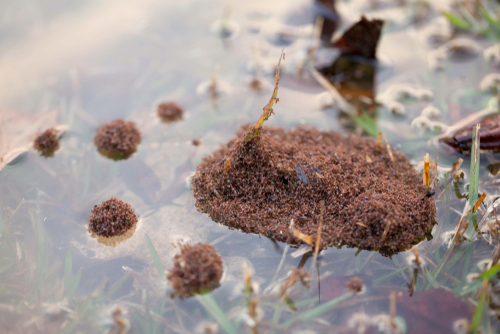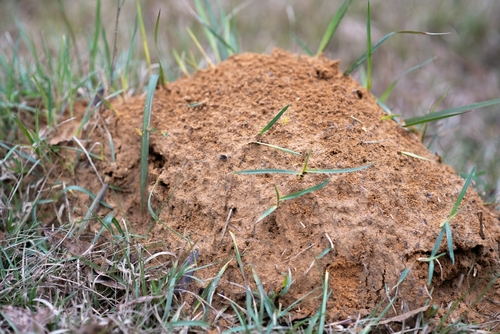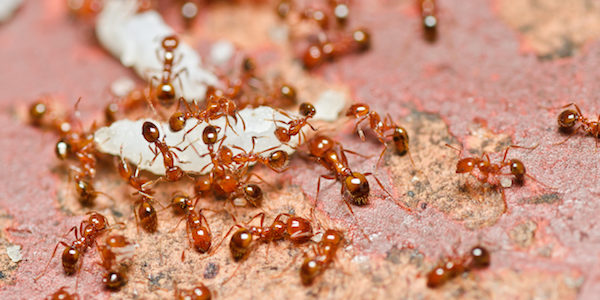Fire ants may have a bad reputation due to their painful stings, but it’s good to know your enemy, right? Despite the danger these small red menaces pose, they are fascinating insects. Let’s examine some of the more surprising fire ants facts that may change the way you look at them.
1. There are Over 280 Different Species of Fire Ant
There are both native and imported varieties or fire ants, which traveled to America in the early 20th century. The imported fire ants tend to be more aggressive but all varieties are capable of painful stings and are part of the genus Solenopsis.
2. Fire Ants Can Be Extremely Aggressive and Kill Small Animals
Fire ants are known to prey upon other insects, birds, small animals and even livestock. While it’s rare that ants would kill a cow or other farm animal, Texas A&M University has a resource on how to treat animals suffering from severe fire ant stings. Fire ant venom can cause itchy welts in most humans. If you have a fire ant allergy or are hypersensitive, you may experience chest pains and/or nausea. In worst case scenarios, you may go into a coma.

3. During a Flood, Fire Ants Will Bind Together To Make a Raft
At any sign of watery danger, fire ants will pick up the unhatched eggs from the nest and latch onto each other to make a raft. They can survive floods and spread to new nesting grounds by floating for extended periods. In this video, ants demonstrate that they can form a raft within two minutes by locking the tips of their legs together.
4. Fire Ants Love Direct Sunlight
You can usually find cone-shaped or domed fire ant mounds in fields, pastures and lawns where they’re subject to constant sun. The ants use the heat to warm the nest and keep their eggs incubating and a cozy 78 degrees. Fire ant nests can prove hazardous for human workers harvesting crops and picking fruit in open areas.
5. They Don’t Have Ears
If there is danger, fire ants will release signal pheromones that alert others to the threat. Instead of listening for sounds, fire ants use their feet to feel for vibrations that tell them where things are located. Creating vibrations can be dangerous. Fire ants are more likely to bite something that is moving rather than still. Unfortunately, reacting to a single fire ant bite could trigger many more.
6. They Do Have Wings
Certain members of the ant colony have wings. These are the reproducers who will fly away from an existing colony to establish a new one. Once the female winged fire ant is fertilized, she will shed her wings and remain on land to begin the new nest.
7. Fire Ants are Crazy Strong
Fire ants can lift 20 times their own body weight. That’s the equivalent of a 100 pound human lifting a ton!

8. Their Nests are Bigger Than You Think
Fire ants build tunnels underground that can go up to 25 feet in length. Not only are these distances impressive, the tunnels are designed to provide just the right stability for travel so that ants can zip up and down them at the equivalent of 30 mph for humans.
9. Populations Continue to Grow and Expand
Fire ants are prolific spreaders. If you think there are more of them now than there used to be, you’re probably right. Originally concentrated in southern states as a result of foreign soil in the form of ship ballast, fire ants have increased their numbers and have spread in all directions.
10. Fire Ants Like Laundry Piles
Swarms of ants have been discovered in laundry piles, especially in wet laundry or after rain or flooding. This may be to seek moisture during drought conditions or because they’re attracted to oils or food residue on the clothing. Check your clothes piles carefully if they’ve sat alone for a while!
Professional Fire Ant Control
It’s better to prevent fire ants before they infest your property, but if you already have fire ants in your house and elsewhere, we can still help! You can usually tell that fire ants are in your yard by the dome or cone-shaped mounds they have built. When exploring for food, they usually enter and exit the mound from holes on the sides. The exit holes on top are mainly used for defending the mound when it is attacked.
Between February and early spring, the mound top will show fresh dirt signaling that the ants are becoming more active. This is the best time for Gregory Pest Solutions to begin applying TopChoice, our preferred treatment for fire ants. It helps control fire ants where applied and also helps prevent new fire ant mounds from developing. We are here to help keep fire ants out of your yard. Call today to learn more and get an appointment booked.

